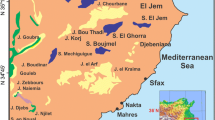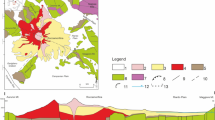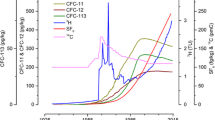Abstract
Geochemistry and environmental tracers were used to understand groundwater resources, recharge processes, and potential sources of contamination in the Rio Actopan Basin, Veracruz State, Mexico. Total dissolved solids are lower in wells and springs located in the basin uplands compared with those closer to the coast, likely associated with rock/water interaction. Geochemical results also indicate some saltwater intrusion near the coast and increased nitrate near urban centers. Stable isotopes show that precipitation is the source of recharge to the groundwater system. Interestingly, some high-elevation springs are more isotopically enriched than average annual precipitation at higher elevations, indicating preferential recharge during the drier but cooler winter months when evapotranspiration is reduced. In contrast, groundwater below 1,200 m elevation is more isotopically depleted than average precipitation, indicating recharge occurring at much higher elevation than the sampling site. Relatively cool recharge temperatures, derived from noble gas measurements at four sites (11–20 °C), also suggest higher elevation recharge. Environmental tracers indicate that groundwater residence time in the basin ranges from 12,000 years to modern. While this large range shows varying groundwater flowpaths and travel times, ages using different tracer methods (14C, 3H/3He, CFCs) were generally consistent. Comparing multiple tracers such as CFC-12 with CFC-113 indicates piston-flow to some discharge points, yet binary mixing of young and older groundwater at other points. In summary, groundwater within the Rio Actopan Basin watershed is relatively young (Holocene) and the majority of recharge occurs in the basin uplands and moves towards the coast.
Résumé
La géochimie et les traceurs environnementaux ont été utilisés pour la compréhension des ressources en eaux souterraines, des processus de recharge, et des sources potentielles de contamination du bassin de la rivière Actopan, Etat de Veracruz, Mexique. Les solides dissous totaux sont plus bas dans les puits et sources localisés dans la partie haute du bassin que dans les secteurs plus proches de la côte, du fait des interactions eau/roches. Les données géochimiques indiquent également des intrusions salines proches de la côte et une augmentation des concentrations en nitrate vers les centres urbains. Les isotopes stables montrent que la pluie constitue la recharge du système aquifère. Il est intéressant de noter que quelques sources de haute altitude sont plus enrichies isotopiquement que la moyenne des précipitations annuelles à ces altitudes ; ceci correspond à une recharge préférentielle durant les mois d’hiver, plus froids et secs, lorsque l’évapotranspiration est réduite. Au contraire, les eaux souterraines sous 1,200 m d’altitude sont isotopiquement appauvries par rapport à la moyenne des précipitations, indiquant une recharge à de plus hautes altitudes que les points d’échantillonnage. Des températures de recharge relativement froides (11–20 °C), obtenues par mesure des gaz nobles sur 4 sites suggèrent également une recharge à une altitude plus élevée. Les traceurs environnementaux indiquent un temps de résidence des eaux souterraines dans le bassin allant de 12,000 ans à l’actuel. Alors que cette différence indique une variabilité importante des flux et des temps de transit, les âges obtenus à l’aide de différents traceurs (14C, 3H/3He, CFCs) sont comparables. La comparaison des différents traceurs entre eux, comme le CFC-12 avec le CFC-113, indique un flux de type piston sur quelques points de décharge et un mélange binaire entre des eaux souterraines jeunes et anciennes à d’autres points. En résumé, les eaux souterraines du bassin de la rivière Actopan sont relativement jeunes (Holocène) et la majeur partie de la recharge prend place dans les parties hautes du bassin et s’écoule vers la côte.
Resumen
Se utilizaron trazadores geoquímicos y ambientales para entender los recursos de agua subterránea, los procesos de recarga y las posibles fuentes de contaminación en la cuenca del Río Actopan, Estado de Veracruz, México. Los sólidos disueltos totales son más bajos en los pozos y manantiales situados en las cabeceras de la cuenca en comparación con las más próximos a la costa, probablemente asociado con la interacción roca/agua. Los resultados geoquímicos también indican alguna intrusión de agua salada cerca de la costa y el aumento de nitrato cerca de centros urbanos. Los isótopos estables muestran que la precipitación es la fuente de recarga al sistema de agua subterránea. Resulta interesante que algunos manantiales de gran altitud tienen un mayor enriquecimiento isotópico que la precipitación media anual de las mayores alturas; esto indica una recarga preferencial en los meses de invierno más secos, pero más fríos cuando se reduce la evapotranspiración. Por el contrario, el agua subterránea por debajo de los 1,200 m de altura está más empobrecida isotópicamente que la precipitación media, lo que indica que la recarga se produce a una mayor altura que el sitio de muestreo. Las temperaturas relativamente frías en la recarga, a partir de mediciones de gases nobles en cuatro sitios (11–20 °C), también sugieren una mayor recarga en altitud. Los trazadores ambientales indican que el tiempo de residencia del agua subterránea en la cuenca varía de 12,000 años a la actualidad. Mientras que esta amplia gama muestra que son consistentes con la variación de las trayectorias del flujo, los tiempos de tránsito y las edades del agua subterránea, utilizando diferentes métodos de trazadores (14C, 3H/3He, CFCs). La comparación de trazadores múltiples tales como CFC-12 con CFC-113 indica flujo pistón en algunos puntos de descarga, pero mezcla binaria de agua subterránea jóvenes y viejas en otros puntos. En resumen, el agua subterránea en la cuenca del Río Actopan es relativamente joven (Holoceno) y la mayoría de recarga se produce en las cabeceras de la cuenca y se mueve hacia la costa.
摘要
利用地球化学和环境示踪剂来了解墨西哥韦拉克鲁斯州Rio Actopan流域地下水资源、补给过程和潜在的污染源。流域高地的井和泉中的溶解固体总量要与接近海岸的井和泉中的溶解固体总含量要低,这可能与岩石/水的相互作用相关。地球化学结果还表明,海岸附近出现海水入侵,城市中心附近硝酸盐含量增加。稳定同位素显示,降水是地下水系统的补给源。有趣的是,一些高海拔泉在更高的地方同位素含量比平均每年降水中的同位素要高;这表明,更干燥但更凉爽的冬季期间蒸发蒸腾减少时,有优先补给。相比之下,海拔1,200米之下的地下水同位素含量比平衡军降水中的同位素要少。在四个地点通过惰性气体测量得到的相对凉爽的补给温度(11–20 °C)也表明有较高海拔的补给。环境示踪剂显示,流域内地下水的滞留时间范围从12,000年到现代。虽然这么大的范围显示各种各样的水流通道迁移时间,但采用不同示踪剂方法(14C, 3H/3He, CFCs)的年龄通常是一致的。通过比较多重示踪剂,诸如CFC-12和CFC-113比较,显示有活塞流到某些排泄点,在其他点存在着年轻地下水和较老地下水的混合。总之,Rio Actopan流域内的地下水相对年轻(全新世),大多数补给出现在流域高地,并向海岸方向运移。
Resumo
Geoquímica e traçadores ambientais foram usados para entender os recursos subterrâneos, processos de recarga, e fontes potenciais de contaminação na Bacia do Rio Actopan, no Estado de Veracruz, México. Os sólidos totais dissolvidos são baixos nos poços e nascentes, localizado nas planícies da bacia em comparação as áreas mais próximas da costa, provavelmente associadas a interação água/rocha. Os resultados geoquímicos também indicam alguma intrusão da água do mar próximo à costa, e aumento das concentrações de nitrato próximo aos centros urbanos. Os isótopos estáveis mostram que a precipitação é a fonte de recarga no sistema subterrâneo. Curiosamente, algumas nascentes mais elevadas são isotopicamente mais enriquecidas que a precipitação média anual nas altas altitudes. Isso indica uma recarga preferencial durante a seca, nos meses mais frios de inverno, quando a evapotranspiração é reduzida. Em contraste, água subterrâneas abaixo de 1,200 m de elevação é isotopicamente mais depletada que a precipitação média, indicando que a recarga ocorre em altitudes muito mais elevadas do que o local de amostragem. Temperaturas relativamente frias de recarga, derivadas a partir de medições de gases nobres em quatro locais (11–20 °C), também sugerem recarga em altas altitudes. Traçadores ambientais indicam que o tempo de residência na bacia varia de 12,000 anos aos dias modernos. Enquanto essa grande variação mostra variações nos padrões de fluxo e no tempo de trânsito, datações utilizando diferentes métodos e traçadores (14C, 3H/3He, CFCs) foram geralmente consistentes. Comparações de múltiplos traçadores como CFC-12 com CFC-113 indicam fluxo de pistão para alguns pontos da descarga, ocorrendo também uma mistura binária das águas subterrâneas jovens e antigas em outros pontos. Em resumo, a água subterrânea dentro da bacia do Rio Actopan é relativamente jovem (Holoceno), e a maioria da recarga ocorre nas planícies da bacia e se move em direção à costa.








Similar content being viewed by others
References
Aeschbach-Hertig W, Peeters F, Beyerle U, Kipfer R (1999) Interpretation of dissolved atmospheric noble gases in natural waters. Water Resour Res 35:2779–2792
Cook PG, Bohlke JK (2000) Determining timescales for groundwater flow and solute transport. In: Cook PG, Herczeg AL (eds) Environmental tracers in subsurface hydrology. Kluwer, Boston, pp 1–30
Comisión Nacional del Agua (CONAGUA) (2002) Actualización de la disponibilidad media anual de agua subterránea. Acuífero (3005) Valle de Actopan Estado de Veracruz México [Updating the annual average availability of groundwater. Aquifer (3005) Actopan Valley, State of Veracruz Mexico]. Gerencia de Aguas Subterráneas, CONAGUA, Mexico City
Coplen TB (1988) Normalization of oxygen and hydrogen isotope data, chemical geology. Isotope Geosci 72(4):293–297. doi:10.1016/0168-9622(88)90042-5
Craig H (1961) Isotopic variations in meteoric waters. Science 133(3465):1702–1703
Fontes JC, Garnier JM (1979) Determination of the initial 14C activity of the total dissolved carbon: a review of the existing models and a new approach. Water Resour Res 15(2):399–413. doi:10.1029/WR015i002p00399
Freeze A, Cherry J (1979) Groundwater. Prentice-Hall, Upper Saddle River, NJ
Gardner PM, Heilweil VM (2014) A multiple-tracer approach to understanding regional groundwater flow in the Snake Valley area of eastern Great Basin, USA. Appl Geochem 45:33–49
Geo-Mexico (2014) Mexico’s seven climatic regions, Geo-Mexico, the geography and dynamics of modern Mexico. http://geo-mexico.com/?p=9512. Accessed 8 December 2014
Goldsmith GR, Muños-Villers LE, Holwerda F, McDonnell JJ, Asbjornsen H, Dawson TE (2011) Stable isotopes reveal linkages among ecohydrological processes in a seasonally dry tropical montane cloud forest. Ecohydrology 5:779–790. doi:10.1002/eco.268
Gómez A (2002) Control temporal del magmatismo de subducción en la porción oriental de la Faja Volcánica Transmexicana: caracerización del manto, components en subducción y contaminación cortical [Temporary control of subduction magmatism in the eastern portion of the Mexican Volcanic Belt: characterization of mantle components in subduction and crustal contamination]. PhD Thesis, Instituto de Geología, UNAM, Mexico
Healy RW, Winter TC, Labaugh JW, Franke OL (2007) Water budgets: foundations for effective water-resources and environmental management. US Geol Surv Circ 1308
Heilweil VM, Healy RW, Harris RN (2012) Noble gases and coupled heat/fluid flow modeling for evaluating hydrogeologic conditions of volcanic island aquifers. J Hydrol 464–465:309–327
Heilweil VM, Sweetkind DS, Gerner SJ (2014) Innovative environmental tracer techniques for evaluating sources of spring discharge from a carbonate aquifer bisected by a river. Groundwater 52(1):71–83
Hernández López C (2012) Análisis del comportamiento de la temperatura y la precipitación mediante climogramas y tendencias en la zona central de Veracruz [Analysis of the behavior of temperature and precipitation by climograms and trends in central Veracruz]. BA Thesis, Universidad Veracruzana, Xalapa, Veracruz, Mexico
Ingerson E, Pearson FJ (1964) Estimation of age and rate of motion of groundwater by the 14C-method. In: Miyake Y (ed) Recent researches in the field of hydrosphere, atmosphere and nuclear geochemistry. Nagoya, Maruzen, Tokyo, pp 263–283
Intenational Atomic Energy Agency (IAEA) (2013) Isotope methods for dating groundwater. IAEA, Vienna
Jones SC, Harr PA, Abraham J, Bosart LF, Bowyer PJ, Evans JL, Hanley DE, Hanstrum BN, Hart RE, Lalaurette F, Sinclair MR, Smith RK, Thorncroft C (2003) The extratropical transition of tropical cyclones: forecast challenges, current understanding and future directions. Weather Forecast 18(6):1052–1092. doi:10.1175/1520-0434(2003)018˂1052:TETOTC˃2.0.CO;2
López-Infanzón M (1991) Petrologic study of the volcanic rocks in the Chiconquiaco-Palma Sola. MSc Thesis, Tulane University, New Orleans, LA, USA
Manga M, Kirchner JW (2004) Interpreting the temperature of water at cold springs and the importance of gravitational potential energy. Water Resour Res 40(5). doi:10.1029/2003WR002905
Magaña V, Vazquez JL, Pérez JL, Pérez JV (2003) Impact of El Niño on precipitation in Mexico. Geof Int 42(3):313–330
Manning AH, Solomon DK (2003) Using noble gases to investigate mountain-front recharge. J Hydrol 275:194–207
Mantua NJ, Hare SR, Zhang Y, Wallace JM, Francis RC (1997) A Pacific decadal climate oscillation with impacts on salmon production. Bull Am Meteorol Soc 78:1069–1079
Méndez González J, Ramírez Leyva A, Cornejo Oviedo A, Zárate Lupercio A, Cabazos Pérez T (2010) Teleconexiones de la Oscilación Decadal del Pacífico (PDO) a la precipitación y temperatura en México [Teleconnections of Pacific Decadal Oscillation (PDO) to precipitation and temperature in Mexico] Invest Geográf 73:28–79
Minder JR, Mote PW, Lundquist JD (2010) Surface temperature lapse rates over complex terrain: lessons from the Cascade Mountains. J Geophys Res 115:D14122. doi:10.1029/2009JD013493
Morales-Barrera W (2009) Estudio geológico de un depósito ignimbrítico en la región de Xalapa, Veracruz: distribución, estratigrafía, petrografía y geoquímica [Geological survey of ignimbrite deposit in the region of Xalapa, Veracruz: distribution, stratigraphy, petrography and geochemistry]. MSc Thesis. Universidad Nacional Autónoma de México, Mexico
Mosiño P, García E (1973) The climate of Mexico. In: Bryson RA, Hare FK (eds) Climates of North America. Elsevier, Amsterdam, pp 345–404
Negendank JFW, Emmermann R, Krawczyk R, Mooser F, Tobschall H, Werle D (1985) Geological and geochemical investigations on the eastern Trans-Mexican Volcanic Belt. Geof Int 24(4):477–575
Newman BD, Osenbrück K, Aeschbach-Hertig W, Solomon DK, Cook P, Rózánski K, Kipfer R (2010) Dating of ‘young’ groundwaters using environmental tracers: Advantages, applications, and research needs. Isot Environ Health Stud 46(3):259–278
Pérez Quezadas J, Cortés Silva A, Inguaggiato S, Salas Ortega MR, Cervantes Pérez J, Heilweil VM (2015) Meteoric isotopic gradient on the windward side of the Sierra Madre Oriental area, Veracruz, México. Geof Int 54(3):267–276
Plummer LN, Busenberg E (2000) Chlorofluorocarbons. In: Cook PG, Herczeg AL (eds) Environmental tracers in subsurface hydrology. Kluwer, Boston, pp 441–478
Plummer LN, Michel RL, Thurman EM, Glynn PD (1993) Environmental tracers for age-dating young groundwater. In: Alley W (ed) Regional ground-water quality. Reinhold, New York, pp 255–294
Plummer LN, Prestemon EC, Parkhurst DL (1994) An interactive code (NETPATH) for modeling net geochemical reactions along a flow path version 2.0. US Geol Surv Water Resour Invest Rep 94-4169
Rasmusson EM, Wallace JM (1983) Meteorological aspects of the El Niño/Southern Oscillation. Science 222(4629):1195–1202
Rodríguez SR, Morales W, Layer P, González E (2010) A Quaternary monogenetic volcanic field in the Xalapa region, eastern Trans-Mexican Volcanic Belt: geology, distribution and morphology of the volcanic vents. J Volcanol Geotherm Res 197:146–166. doi:10.1016/j.jvolgeores.2009.08.003
Salas-Ortega R (2010) Estudio geológico e hidrogeoquímico de un sistema de manantiales en la región de Xalapa, Veracruz [Geological and hydro-geochemical study of a system of springs in the region of Xalapa, Veracruz]. MSc Thesis, Universidad Nacional Autónoma de México, Mexico
Santamaría-Orozco D, Arenas-Partida R, Escamilla-Herrera A (1990) Normalización de la Nomenclatura Estratigráfica en las Cuencas Mesozoicas de México [Stratigraphic nomenclature normalization of Mesozoic basins in Mexico]. Inst Mex Petróleo 19:102–106
Servicio Geológico Mexicano (SGM) (2007a) Carta Geológico-minera Xalapa E14-B27 Veracruz Escala 1:50 000 [Geological map Xalapa E14-B27 Veracuz Scale 1:50,000]. Consejo de Recursos Minerales, Pachuca, Hidalgo, Mexico
Servicio Geológico Mexicano (SGM) (2007b) Carta Geológico-minera Perote E14-B26 Veracruz Escala 1:50 000 [Geological map Perote E14-B26 Veracruz Scale 1:50,000]. Consejo de Recursos Minerales, Pachuca, Hidalgo, Mexico
Servicio Geológico Mexicano (SGM) (2010) Carta Geológico-minera Coatepec E14-B37 Veracruz-Puebla Escala 1:50 000 [Geological map Coatepec E14-B37 Veracruz-Puebla Scale 1:50,000]. Servicio Geológico Mexicano, Pachuca, Hidalgo, Mexico
Solomon DK (2000) 4He in groundwater. In: Cook PG, Herczeg AL (eds) Environmental tracers in subsurface hydrology. Kluwer, Boston, pp 425–439
Solomon DK, Genereux DP, Plummer LN, Busenberg E (2010) Testing mixing models of old and young groundwater in a tropical lowland rain forest with environmental tracers. Water Resour Res 46. doi:10.1029/2009WR008341
Stute M, Schlosser P (2000) Atmospheric noble gases. In: Cook PG, Herczeg AL (eds) Environmental tracers in subsurface hydrology. Kluwer, Boston, pp 349–377
Sutton R, Hodson D (2005) Atlantic ocean forcing of North American and European summer climate. Science 309(5731):115–117. doi:10.1126/science.1109496
Tamers MA (1975) Validity of radiocarbon dates on groundwater. Geophys Surv 2(2):217–239. doi:10.1007/BF01447909
Tejeda A, Acevedo F, Jáuregui E (1989) Atlas Climático del Estado de Veracruz Colección Textos Universitarios [Climate Atlas of the state of Veracruz Texts university collection]. Universidad Veracruzana, Xalapa, Mexico
Vázquez JL (2007) Variabilidad de la precipitación en la República Mexicana [Variability of precipitation in the Mexican Republic]. PhD Thesis, Universidad Nacional Autónoma de México, Mexico
Viniegra-Osorio F (1965) Geología del Macizo de Teziutlán y la Cuenca Cenozoica de Veracruz y La Cuenca Cenozoica de Veracruz Papaloapan [Teziutlán Massif Geology and Cenozoic Basin Veracruz]. Bol Asoc Mexicana Geól Petrol 1:315–384
Wegner RA, Brand WA (2001) Referencing strategies and techniques in stable isotope radio analysis. Rapid Commun Mass Spectrom 15:501–519. doi:10.1002/rcm.258
Yager RM, Plummer LN, Kauffman LJ, Doctor DH, Nelms DL, Schlosser P (2013) Comparison of age distributions estimated from environmental tracers by using binary-dilution and numerical models of fractured and folded karst: Shenandoah Valley of Virginia and West Virginia, USA. Hydrogeol J 21(6):1193–1217
Acknowledgements
Authors are thankful to the Consejo de Ciencia y Tecnología, CONACyT, for the support provided to the first author of this study. Sincere thanks are due to the staff of the Stable Isotope Laboratory of the Geology Institute, Autonomous University of Mexico (Pedro Morales Puente and Edith Cienfuegos Alvarado) as well as the Hydrochemistry Laboratory at the Geosciences Centre, UNAM (Carolina Muños Torres). We also thank Dr. Kip Solomon for providing the Excel-based “CalcAge” software used for noble-gas recharge temperature, 3H/3He age, and 4Heterr interpretations. We also thank the USGS Reston Groundwater Dating Laboratory for providing the Excel-based software used for chlorofluorocarbon dating. Part of this study was carried out as part of the Technical Cooperation Project MEX7010, supported by the International Atomic Energy Agency.
Author information
Authors and Affiliations
Corresponding author
Electronic supplementary material
Below is the link to the electronic supplementary material.
ESM 1
(PDF 360 kb)
Rights and permissions
About this article
Cite this article
Pérez Quezadas, J., Heilweil, V.M., Cortés Silva, A. et al. A multi-tracer approach to delineate groundwater dynamics in the Rio Actopan Basin, Veracruz State, Mexico. Hydrogeol J 24, 1953–1966 (2016). https://doi.org/10.1007/s10040-016-1445-4
Received:
Accepted:
Published:
Issue Date:
DOI: https://doi.org/10.1007/s10040-016-1445-4




